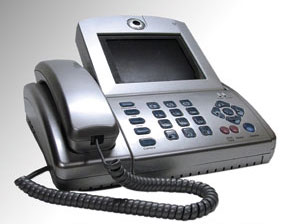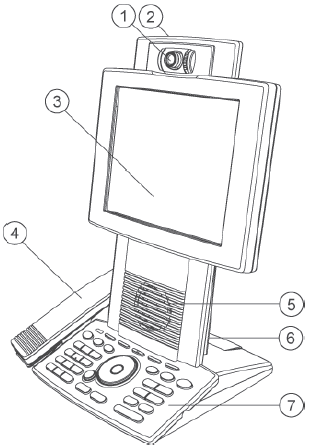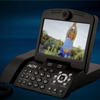Cisco has a new Color IP VideoPhone called the Cisco IP Phone 7985G Videophone coming to market that until now has been kept under top-secret wraps. According to the interim spec I received from an insider, it makes no mention of SIP, so you'll probably need Cisco CallManager to get all the bells and whistles working. Just what we need another proprietary videophone. <sigh> I hope they'll eventually take my advice and make all these videophones interoperate. I'd love to see the Cisco videophone work with the Packet8 videophone or the Vonage videophone. As of right now I cannot confirm this new Cisco IP phone on Cisco's website nor any product or concept images or I would have included them here. Don't get excited over the image to the left. That isn't the Cisco videophone. The image to the left is actually the Vonage videophone OEM'ed from Videon. I was just teasing you, but my guess is that it will look very simiilar.. The Vonage videophone and the Packet8 videophone look nearly identical.
As of right now I cannot confirm this new Cisco IP phone on Cisco's website nor any product or concept images or I would have included them here. Don't get excited over the image to the left. That isn't the Cisco videophone. The image to the left is actually the Vonage videophone OEM'ed from Videon. I was just teasing you, but my guess is that it will look very simiilar.. The Vonage videophone and the Packet8 videophone look nearly identical.
According to my source the Cisco videophone was originally supposed to be available today, but it must has been pushed back since I can't find any mention if it anywhere.
According to their specs they are positioning it by stating "the Cisco IP Phone 7985G Videophone is a personal desktop video phone for the Cisco IP Communications solution." According to the Cisco document it offers "executives and managers a productivity-enhancing tool that makes instant, face-to-face communication possible from their offices, the Cisco IP Phone 7985G has all the components to enable a video call—camera, LCD screen, speaker, keypad, and a handset—incorporated into one easy-to-use unit."
One feature mentioned below that caught my eye was that it mentions that the color LCD will be less bright if running using 802.3af PoE (Power over Ethernet) instead of using the included power supply. What the heck is that? They didn't design the 802.3af spec to handle power hungry color LCDs? I have to use stick big A/C power brick under my desk just to get the best LCD experience? The whole point of PoE is to eliminate A/C bricks, have 1 wire to the IP phone, and provide centralized battery backup to all IP phones. Perhaps the brightness difference is only negligible, but still. Guess I'll have to ask Cisco to send me a unit to test and figure out if it's a huge brightness difference or not. In any event, check out the features from their specs...
Features
The Cisco IP Phone 7985G is dynamic, and it is designed to grow with system capabilities. Call features such as call forward, transfer, conference, and hold are now available with video and are all initiated through the IP phone. IP telephony and IP video telephony are delivered to every employee using a unified dial plan and a common directory—over a single Cisco IP Communications infrastructure—through Cisco CallManager.
Features will keep pace with new changes through software updates to the phone flash memory. No hands-on moves and changes are required with the phone—the user can simply pick up the phone and move to the new location anywhere on your network. The Cisco IP Phone 7985G provides many accessibility methods according to user preference. In addition to the four Directories, Services, Settings, and Messages buttons, the Cisco IP Phone 7985G has five buttons to control video features.
Messages— The phone offers direct access to voicemail.
Directories — The phone identifies incoming messages and categorizes them on the screen, allowing users to quickly and effectively return calls using direct dial-back capability. The corporate directory integrates with the Lightweight Directory Access Protocol Version 3 (LDAP3) standard directory.
Settings — The Settings feature key allows the user to adjust display contrast, select background images (if available), and select from a large number of unique ringer sounds through the User Preference menu. Network Configuration preferences also can be set up (usually by the system administrator). Configuration can be either automatically or manually set up for Dynamic Host Configuration Protocol (DHCP), Trivial File Transfer Protocol (TFTP), Cisco CallManager, and backup Cisco CallManagers.
Services — The Cisco IP Phone 7985G allows users to quickly access diverse information such as weather, stocks, quote of the day, or any Web-based information using Extensible Markup Language (XML) to provide a portal to an ever-growing world of applications, features, and information.
Help — The online Help feature gives users information about the phone keys, buttons, and features.
Speakerphone, Mute, and Headset Buttons — The phone features high-quality, speakerphone technology, including an easy-to-use speaker On/Off button, Microphone Mute button, and Headset button.
These buttons are lit when active.
Ethernet Switch — The internal Cisco 2-port Ethernet switch allows for a direct connection to a 10/100BASE-T Ethernet network through an RJ-45 interface with single LAN connectivity for both the phone and a co-located PC. The system administrator can designate separate VLANs (802.1Q) for the PC and Cisco IP phones, providing improved security and reliability of voice and data traffic.
Headset Port — A dedicated headset port eliminates the need for a separate amplifier when using a headset. This feature allows the handset to remain in its cradle, making headset use simpler. Note: Best headset sound quality can be achieved, by using recommended Plantronics MX100 headset.
Volume Control — The convenient Volume Control button on the phone provides for easy decibel-level adjustments for the speakerphone, handset, headset, and ringer. The handset offers Americans with Disabilities Act (ADA) and hearing aid-compatible (HAC) compliance, with a maximum handset volume of 13 dB. New US Section 508 Accessibility capability can be achieved using an in-line handset amplifier such as Clearsound IL-40 Portable Telephone Amplifier.
Self View — The Self View button switches the video image from incoming to outgoing video. Self View displays your outgoing picture in full screen. This feature allows you to see what is being transmitted to the other end.
Picture in Picture (PIP) — PIP displays a smaller picture of the outgoing video. The PIP is displayed on top of the bigger incoming picture when users are in a call, allowing them to see both pictures at the same time.
Video Mute — This button toggles the Video Mute feature on or off. When Video Mute is active, the video phone does not send out the user’s video image. The far-end video phone displays a muted-video icon indicating the near-end user is on video mute.
Display Button — This button toggles the menu on and off. With this button, all the information displayed on the phone screen—soft-key labels, lines, and call information—can be essentially removed and the video image can be set for full-screen view.
Brightness Button — This button controls monitor brightness.
Flexible Power Options — The Cisco IP Phone 7985G can receive power down the LAN from any Cisco IEEE 803.3af Power over Ethernet (PoE) switch. It also can be powered locally with a power supply (part number CP-PWR-CUBE-3). Note: To achieve full LCD brightness, use the local power supply, The LCD will have reduced brightness levels while operating in IEEE 802.3af PoE mode.
Multiple Ring Tones — More than five user-adjustable ring tones are available.
ADA Features — A HAC handset (meets ADA requirements) is available, as well as HAC compliance for magnetic coupling to approved HAC hearing aids. The dial pad also is ADA-compliant.
Signaling Protocol Support — The phone offers Skinny Client Control Protocol (SCCP) support.
Codec Support — G.711µ, G.729ab, and G722 audio compression codecs are available.
Configuration Options — IP address assignment can be statically configured or configured through the DHCP.
Voice Quality — Comfort-noise generation and voice activity detection (VAD) programming are performed on a system basis.
Update: (15 min from original post)
Found this regulatory statement for the 7985G on Cisco's website, but not much info on the color screen or video.
This tidbit on the Cisco 7985G videophone is pretty amusing though:
Statement 355 applies only to the Cisco IP Phone 7985G..
Telephone receivers produce a magnetic field that can attract small magnetic objects such as pins and staples. To avoid the possibility of injury, do not place the handset where such objects may be picked up. Statement 355
So why is it that only the Cisco IP Phone 7985G has magnetic issues with metal pins and staples? I'm reminded of a scene from Crouching Tiger Hidden Dragon where a peson was killed by a single metal pin to the neck. I can see the warning labels now "Do not make VoIP calls with metal pins or staples within a 6 foot radius. Doing so may result in flying pins or staples resulting in injury or death. If injured, dial 911 immediately. Assuming you have acknowledged the e911 rules mandated by the FCC your call will be connected. If not, we can't help you. You're going to die and Cisco shall not be held liable."
Update 2: Saturday 9:33pm EDT
Just found an image (diagram) of the new Cisco videophone that I thought I'd share. I was wrong about it looking like the Vonage or Packet8 videophone it actually looks more like the Motorola Ojo videophone.
android apple asterisk at&t blackberry cell phone cisco dell digium e911 facebook fcc google google talk gps im ip-pbx ipad iphone ipod itexpo ITEXPO lync microsoft mobile phone open source outage phone review sip skype sony unified communications verizon video video conferencing voip vonage wireless xbox 360
- Apple (280)
- Bittorrent (2)
- Call Center and CRM (48)
- Computer Hardware (183)
- Computer Software (71)
- Gadgets (650)
- Google (225)
- Home Entertainment (263)
- Internet (173)
- Linux (111)
- Microsoft (376)
- MovableType (48)
- News (187)
- Personal and Humor (118)
- Politics (9)
- Reviews (246)
- Security (2)
- Social Networking (42)
- Sports/Outdoor Technology (9)
- Tablets (32)
- Technology and Science (355)
- Unified Communications (471)
- VoIP (2285)
- Wireless (584)
- p2p (20)
- March 2014
- February 2014
- January 2014
- December 2013
- November 2013
- October 2013
- September 2013
- August 2013
- July 2013
- June 2013
- May 2013
- April 2013
- March 2013
- February 2013
- January 2013
- December 2012
- November 2012
- October 2012
- September 2012
- August 2012
- July 2012
- June 2012
- May 2012
- April 2012
- March 2012
- February 2012
- January 2012
- December 2011
- November 2011
- October 2011
- September 2011
- August 2011
- July 2011
- June 2011
- May 2011
- April 2011
- March 2011
- February 2011
- January 2011
- December 2010
- November 2010
- October 2010
- September 2010
- August 2010
- July 2010
- June 2010
- May 2010
- April 2010
- March 2010
- February 2010
- January 2010
- December 2009
- November 2009
- October 2009
- September 2009
- August 2009
- July 2009
- June 2009
- May 2009
- April 2009
- March 2009
- February 2009
- January 2009
- December 2008
- November 2008
- October 2008
- September 2008
- August 2008
- July 2008
- June 2008
- May 2008
- April 2008
- March 2008
- February 2008
- January 2008
- December 2007
- November 2007
- October 2007
- September 2007
- August 2007
- July 2007
- June 2007
- May 2007
- April 2007
- March 2007
- February 2007
- January 2007
- December 2006
- November 2006
- October 2006
- September 2006
- August 2006
- July 2006
- June 2006
- May 2006
- April 2006
- March 2006
- February 2006
- January 2006
- December 2005
- November 2005
- October 2005
- September 2005
- August 2005
- July 2005
- June 2005
- May 2005
- April 2005
- March 2005
- February 2005
- January 2005
- December 2004
- November 2004
- October 2004
- September 2004
- August 2004
- July 2004
- June 2004
- May 2004
- April 2004
- March 2004
Featured Videos













